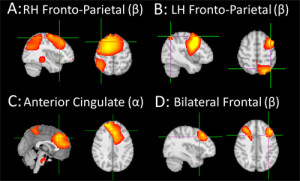Attention and memory in childhood
What we are interested in
Children’s brains go through a huge amount of change during the process of development, and these brain changes allow for the improvements in cognitive abilities – such as the ability to pay attention, ignore distraction, or store things in memory – that we see as kids get older.
We are particularly interested in selective attention (the ability to pay attention to specific things while ignoring distraction) and short-term/working memory (the ability to store information in the mind for a short period of time and manipulate it). These abilities are important to research as they play important roles in the learning experience and can affect things like academic achievement.
How we do it
We use different research methods to understand the patterns of brain activity that occur when you use these cognitive abilities such as focusing your attention or temporarily remembering some information.
Two research methods we use are electroencephalography (EEG) and magnetoencephalography (MEG). Both methods are widely used with both child and adult research participants, and both involve the participant being seated comfortably in a chair and having the sensors positioned over their head. The sensors just sit on or close to the head and record the naturally occurring brain activity. Once we have recorded this activity, we can analyse it to understand patterns of brain activity that are associated with attention and memory.
What we have found so far
One study we have been working on has looked at the effects of brain training on patterns of brain activity in children aged 8 to 11. We were interested in whether the brain training improved short-term/working memory ability in kids, and also how it might change particular brain activity patterns. The training did improve short-term/working memory ability in our participants, and this improvement was associated with a change in a connection between two different brain areas – the stronger the connection between these areas, the better the short-term/working memory performance of our participants. This is an important finding because researchers around the world are still trying to understand exactly what effect brain training has on the brain.

Some brain activity patterns identified in our most recent study.
How to take part
We have further studies planned as part of this research into attention and memory in childhood, and we are always keen to hear from parents and children who might be interested in helping us with our research by participating in our studies. If you would like to learn more about our research and how to get involved, please click here or email Dr Duncan Astle (duncan.astle@mrc-cbu.cam.ac.uk).
Please note, the Attention & Memory in Childhood research programme is separate from the CALM clinic. If you are a parent and your child has a learning difficulty and a specialist or practitioner has suggested your child should attend CALM, please click here to learn about how to get involved with CALM research.

 Centre for Attention Learning and Memory
Centre for Attention Learning and Memory